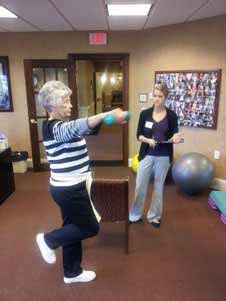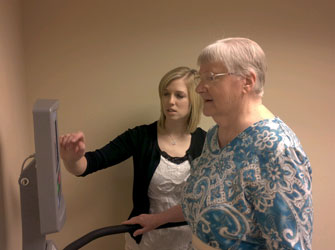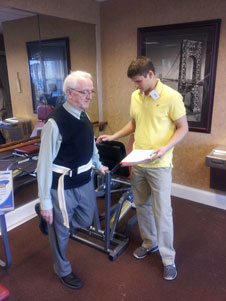Enhance resident care, attract more patients, strengthen partnerships and prove better outcomes… in less time.

In the News
When Providers and Universities Partner, Seniors, Students and Research Benefit

University Place resident Bev Blume works with Purdue student Mollie Semmer as part of the university’s “Motor Function in Older Adults” course.
Prof. Donald Corrigan arrived in West Lafayette, IN, in 1965 to teach exercise physiology at Purdue University. For more than 40 years, Corrigan was always moving, dedicating his life to educating undergraduates as well as serving as head coach for the Purdue wrestling team.
Recently, Corrigan has been “slowing down” due to hip complications. A former marathon runner, he knew that the running that once kept him in shape would have to be replaced by more basic strength training. During a recent balance training session, conducted by Purdue undergraduate students at University Place in West Lafayette, Corrigan shouted with a wide smile, “If you don’t do anything, you end up with nothing, so I felt it was time to have this old dog learn some new tricks!”
The expression from Corrigan is an example of what University Place, a continuing care retirement community, and Purdue University wanted to achieve when they embarked on a formal affiliation. Since 2003, University Place and Purdue have partnered to create educational opportunities, faculty research, undergraduate internships and intellectual wellness programs, and to provide real-life training opportunities for the health and medicine departments within Purdue.
The formal affiliation contract is reviewed every five years in order to ensure that contractual goals are being met.
An advisory committee made up of Purdue faculty members, University Place management and residents meets biannually to address any concerns or recommendations. Moreover, through the affiliation, Purdue manages and operates the fitness center and wellness programming for University Place.
Six academic departments, 100 undergraduate and graduate students, 20 seniors from the local community and 60 University Place residents participate in aging-science programming.
“The most important component for a successful affiliation is having the right faculty members who share a common vision for serving senior adults,” says Steve Bardoczi, acting University Place executive director and senior vice president of ministry development for Franciscan Communities, University Place’s parent organization. “We want to make sure that we don’t tell them what to do, and they don’t tell us what to do, but rather a relationship built on a common ground for serving senior adults.”
[Editor’s note: Since this article was written, University Place has hired a new executive director, Jeremy Gerrish.]
In 2010, University Place dedicated a 1,500-square-foot space to house a satellite of Purdue’s Center on Aging and the Life Course (CALC). Purdue’s CALC includes more than 60 faculty associates from a wide range of disciplines including clinical pharmacy, nutritional science, gerontology, speech, language and hearing science, and nursing. The majority of the research focuses on finding interventions that stave off age-related problems in older adults, rather than treating those problems after they have occurred.

University Place resident Elfa Taylor works with Purdue student Erica Zartman on the Biodex balance machine, which assesses overall individual stability and balance in order to improve postural stability, weight shift and center-of-gravity control..
“We emphasize the process of aging and maintaining functionality,” explains Prof. Ken Ferraro, director of CALC.
By locating the satellite CALC within a CCRC, the center can provide real-life training experience for undergraduate students and provide research space and access to a pool of older adult research participants.
“The main purpose ... was to have a meaningful relationship built upon facilitating opportunities within aging science research and student engagement,” Ferraro says.
Senior living providers interested in collaborating with a university must be mindful that the university is also a not for-profit organization reliant upon state and federal dollars. Faculty work in a very competitive environment for research grants, and they must look at private partnerships to finds ways to support their research. Since the initial dedication of research space, Purdue and University Place have partnered to purchase capital equipment for CALC faculty. The two organizations saw their affiliation as a way to support faculty dedicated to aging science research.
“We were able to share the initial cost of a few pieces of equipment once we knew our initial collaboration would be a success,” Ferraro says.
One of the most successful CALC programs emerged from within the Department of Health & Kinesiology. Associate professors Jeff Haddad and Shirley Rietdyk created a senior-level course titled “HK490: Motor Function in Older Adults.” It provides a real-life training experience for senior students interested in working with older adults, using training methods and equipment meant to improve balance and assess an individual’s ability to make positive changes.
The researchers believe better balance control may lead to better mechanical control overall. Moreover, both agree that the undergraduate students receive a life experience and always complete the course with a strong understanding of whether or not they want to work with older adults.
“We generally have students who complete the course and have an even stronger desire to enter the fields of physical and occupational therapy, and we also have those few who decide working with older adults is just not for them,” Haddad says.
Ten Reasons To Do Aging Research in a Retirement Community
- The provider can better understand where to invest capital dollars within its community wellness program.
- Aging science programs provide data-driven outcomes for clinical and resident satisfaction.
- A university affiliation will offer a direct community benefit, thereby supporting a not-for-profit property tax exemption.
- Residents will test interventions that may benefit their lives.
- Through their relationship with residents, students will develop a deeper understanding of aging.
- Researchers will gain a pool of research participants from across the health continuum.
- Given their familiar surroundings, research participants will feel less stressed than those who may go to a research laboratory.
- Research data might help the aging-services field create beneficial programs and policies for residents.
- Aging-science research provides opportunities for non-residents who live within the community to participate and experience the community.
- Supporting aging-science research will enhance the relationship with local hospitals, and may provide better clinical outcomes to be shared with case managers, discharge planners, specialty physicians and hospital administrators.
Tiphanie Raffegeau, the Purdue graduate student in health and kinesiology who is supervising the students, explains, “The quantitative outcomes of the program are the improvements in gait and walking ability; the qualitative outcomes are more emotional and include interpersonal communication, joy and overall confidence.”
When talking about the research outcomes, Raffegeau quickly points to the undergraduate experience as being able to empathize, relate and listen to the resident participants: “We have plenty of laughs and tears throughout the semester,” she says. “You can see our impact in the faces of the older adults when they interact with the students.”
The students may begin the class with their own perceptions of older adults and their physical abilities. For many, this is an opportunity to break down stereotypical images of older adults and learn that working with older adults is engaging and that they can also be very physically fit.
Kristen Michels, a junior in movement and sports science, had such an “a-ha moment” during her first week at University Place. “I was working with two residents, one who was 69 years old and works out three times a week and the other resident who is 92 years old and plays golf once a week,” she says. “I really didn’t expect the resident participants to be that active.”
For many undergraduate students, interacting with older adults in a research setting allows them to gain a better understanding of how they need to relate when motivating the resident participants.
“I think the biggest challenge for me has been dealing with the emotional stress of the older adult,” says Dana Stumpf, a senior in movement and sports science. “Sometimes, the participant is just cranky, in pain or just down.”
It is important for the students to learn how to coach and cooperate with the resident participants–to create trust and build the resident’s confidence during the balance training research session.
“I realized that it is important to not just focus on the physical wellness goals of the balance program, but the emotional wellness aspects as well,” Stumpf says. “A resident participant recently lost his spouse and I really didn’t know how to react, but I soon realized that it was my job to listen and just continue to motivate him as he was completing the exercises.”
The way the undergraduate students relate to the residents has a direct effect on how they relate to their own grandparents.
“I have been a lot more patient with my own 91-year-old grandmother,” says Erica Zartman, a junior in movement and sports science, “Since my grandmother’s hearing has decreased and she has slowed down, I realize that I need to adapt to her, slow down and interact with her differently.”
Understanding adaptability and the importance of patience are two life lessons the students learn when working with the residents.

University Place resident Tom Kelly works on balance exercises with student Kyle Kelly.
“Life can be pretty tough, and I see how difficult it is for the older adults to challenge themselves through working on specific exercises and how much patience and perseverance it takes to succeed,” Zartman says. “I gained an understanding that in order to be successful, you have to be adaptable and realize that working with people isn’t always smooth.”
For many residents, the opportunity to work side-by-side with a student allows them to encourage and support the students in their professional aspirations. Resident Elfa Taylor understands that the students are learning, and she plays an integral role in their success.
“Some of these students are very, very self-assured, and there are also the students that are very timid and shy,” Taylor says. “I know that one of the gifts I can give them is to support their professional aspirations and encourage them to look for ways to better themselves.”
As a two-year participant in the balance study, Taylor says that she continues to be impressed with the undergraduates. “They come to our community dressed professionally, speak clearly and are very polite,” she says.
“I appreciate how goal-oriented the students are and how they are willing to go the extra mile for me.”
To be enrolled in the course, students were selected by Haddad and Rietdyk based on their academic performance within their majors as well as their passion for working with older adults. For many students, graduate school is their main priority.
One of the major advantages of the affiliation has been the ability to create an aging science component within the fabric of the overall resident wellness program. More importantly, University Place and Purdue are developing future senior service leaders.
“I continue to be amazed every time I am in the retirement community with how much I enjoy the residents,” Stumpf says. “A resident recently asked me to participate in the line dancing class at University Place, and I love to dance, so I think I will take him up on his offer.”
Mike Logan, MHA, was executive director for University Place, West Lafayette, IN, from 2006-2012, and developed the partnership with the Purdue University Center on Aging and the Life Course (CALC). Logan is now director of operations services for Sawgrass Partners, LLC, and is a LeadingAge Leadership Academy Fellow.
Reference:
http://www.leadingage.org/magazine/Feature.aspx?id=6469
Biodex can give your facility The Referral Advantage™
ACCELERATED REHAB | IMPROVED OUTCOMES | REDUCED RISK OF READMISSIONS
To schedule an online presentation or for more information, Call 1-800-224-6339 or Email seniorrehab@biodex.com



 Biodex Medical Systems, Inc., 20 Ramsey Road, Shirley, NY 11967-4704
Biodex Medical Systems, Inc., 20 Ramsey Road, Shirley, NY 11967-4704